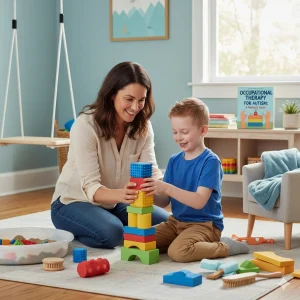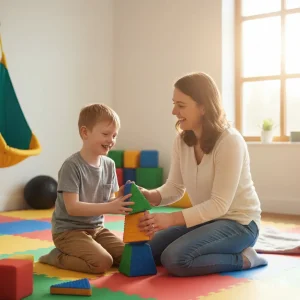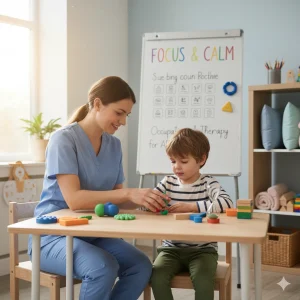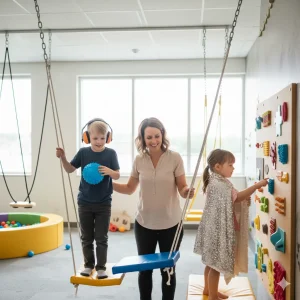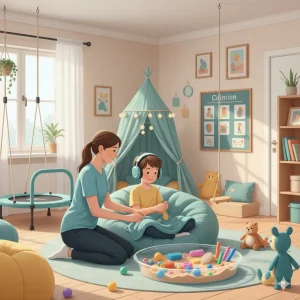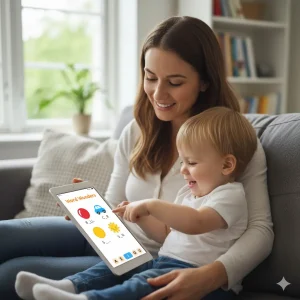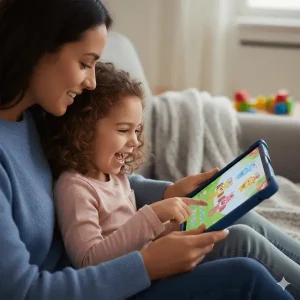My 3-Year-Old Doesn’t Tell Stories — Is This a Red Flag?
Last Updated: August 20, 2025
“Mommy, guess what happened at school today?” — for many parents, these little stories are a highlight of life with a preschooler. But what if your 3-year-old doesn’t tell stories at all? If your child can’t describe their day, retell a simple storybook, or engage in pretend play, you may be left wondering: Is this just a phase, or a red flag in language development?
Storytelling is more than just cute chatter — it’s a key language milestone that helps children connect ideas, share experiences, and build social skills. By age three, many toddlers start piecing together short narratives, answering “who,” “what,” and “where” questions, and engaging in simple pretend play. But every child develops differently, and not all delays are a cause for alarm.
Free Speech Help for Kids
Concerned about speech delays? Book a free consultation with our expert speech therapist and get guidance tailored to your child’s needs.
What Storytelling Looks Like at Age 3
By the time children turn three, many parents notice big leaps in how their little one communicates. At this stage, toddlers are not just using words to ask for snacks or toys — they’re beginning to put ideas together in ways that resemble simple stories. While every child develops at their own pace, understanding the typical language milestones for a 3-year-old can help you know what to expect.
Typical Language Milestones for a 3-Year-Old
Around age three, many children:
- Speak in short 3–5 word sentences (e.g., “I go park” or “Daddy read book”).
- Start using basic grammar like plurals (“dogs”) or simple past tense (“played”).
- Ask and answer simple “what” or “where” questions.
- Share short bits of information, like telling you, “I eat cookie” or “I play ball.”
These early language skills form the building blocks for storytelling. While their sentences may not yet flow like a full story, your child is learning how to connect events and ideas.
Early Signs of Narrative Skills
Narrative skills — the ability to tell a story or explain what happened — emerge gradually. A 3-year-old might not yet be able to give a detailed account of their day, but you may notice early steps, such as:
- Talking about daily events in short bursts (“We go school,” “Teacher sing song”).
- Remembering and naming characters from familiar books or cartoons.
- Sequencing two ideas together (“We eat, then nap”).
- Repeating parts of a story you’ve just read.
These small steps show your child is beginning to organize thoughts into a sequence, which is the foundation of storytelling.
The Role of Pretend Play and Imagination
One of the strongest indicators of early storytelling is pretend play. When your child picks up a toy car and says, “Vroom, car go home,” or puts a doll to bed and says, “Baby sleepy,” they’re not just playing — they’re creating a mini story. Pretend play allows toddlers to explore characters, settings, and actions, which are all essential parts of narrative development.
Imaginative play also helps children practice social communication. For example, when a child pretends to cook dinner and serve it to you, they’re learning how to connect actions into a sequence and share that sequence with another person. These skills directly support storytelling and later, more advanced conversation.
Why Toddlers Struggle to Tell Stories
It’s natural for parents to feel worried when their 3-year-old doesn’t tell stories, but in many cases, the reason is simply that children develop these skills at different speeds. Storytelling requires more than just words — it involves memory, sequencing, imagination, and confidence. Some toddlers take longer to put all these pieces together. Let’s look at a few common reasons why a child may not yet be ready to tell stories.
Normal Developmental Variation
Not every child follows the same timeline. While some 3-year-olds are already able to describe their day in short sentences, others may still be focused on labeling objects or using simple requests. This doesn’t always mean there’s a problem. Developmental milestones are broad ranges, not strict deadlines. For example, one child may start weaving little stories at 2 years and 9 months, while another may only begin closer to 4 years old. Both can still fall within a typical range.
Expressive vs. Receptive Language Differences
A big reason parents worry is that their child seems to understand everything but doesn’t speak much in return. This is the difference between receptive language (understanding words, instructions, and stories) and expressive language (using words and sentences to share ideas). Many toddlers have strong receptive language but are slower in expressive skills, which makes storytelling harder. In other words, your child may understand a story you read to them, but they may not yet be able to retell it in their own words.
Common Reasons Toddlers Struggle With Storytelling
There are several everyday reasons a toddler may not be telling stories yet:
- Limited vocabulary – Without enough words to describe people, places, and actions, it’s difficult to form even a simple story.
- Sequencing difficulties – Storytelling relies on organizing events in order (“first we ate dinner, then we took a bath”). Some children take longer to develop these sequencing skills.
- Shyness or personality – A quieter or more reserved child may simply not share stories out loud, even if they’re practicing them internally during play.
- Late talking – If your child started speaking later than peers, storytelling may naturally be delayed as well.
When “Not Telling Stories” Becomes a Red Flag
While many children develop storytelling skills at different paces, there are times when a 3-year-old not telling stories could signal something more than just a late bloomer. Storytelling ties closely to expressive language development, pretend play, and social communication. When these areas are consistently behind, it may be worth a closer look.
Signs of Expressive Language Delay
One of the most common reasons for concern is an expressive language delay. This means a child struggles to use words and sentences to express themselves, even though they may understand what others are saying. Warning signs include:
- Difficulty forming sentences beyond two words.
- Trouble using action words (“run,” “eat,” “play”) or describing simple events.
- Rarely attempting to explain or share what happened during their day.
If your child has good understanding but consistently avoids talking or can’t explain simple experiences, it’s worth discussing with a speech-language pathologist.
Lack of Back-and-Forth Conversation
By age three, most toddlers begin engaging in short conversations — even if their stories are jumbled. If your child rarely responds when spoken to, avoids answering questions like “What did you do today?”, or struggles to take conversational turns, this could be a red flag in communication development. Conversation skills are essential for storytelling, and their absence may suggest underlying language or social difficulties.
No Interest in Pretend Play or Story Retell
Pretend play is a powerful way toddlers practice storytelling. When a child puts a doll to bed, cooks with toy food, or makes animal noises with figurines, they’re building the foundation for narrative skills. A lack of interest in imaginative play, story retell, or role-playing can sometimes indicate developmental concerns. It’s not just about fun — pretend play shows a child can imagine, sequence, and share experiences.
Possible Links to Autism and Social-Communication Challenges
In some cases, limited storytelling may point toward autism spectrum disorder (ASD) or other social-communication challenges. Children with autism may struggle to:
- Share experiences through language.
- Engage in joint attention (pointing out or commenting on what they see).
- Use pretend play naturally.
- Build stories that include characters, feelings, or social details.
Not telling stories on its own does not mean a child has autism, but when combined with other signs — such as avoiding eye contact, limited gestures, or difficulty with social interaction — it becomes an important signal to seek guidance.
In short, while some 3-year-olds simply need more time, a consistent lack of storytelling combined with delayed expressive language, weak conversation skills, or no interest in pretend play may be a red flag for developmental concerns. Early evaluation and support can make a big difference in helping children catch up and thrive.
How Storytelling Supports Development
Storytelling is more than just a cute milestone — it’s a window into your child’s growing mind. When your 3-year-old begins to tell stories, even in simple, broken sentences, they’re practicing skills that will shape their language, thinking, and relationships for years to come.
The Connection Between Storytelling, Communication, and Thinking
When toddlers tell stories, they’re learning how to turn thoughts into words. This process strengthens both communication and cognitive development. To describe what happened at preschool or make up a story about their toys, a child has to:
- Recall events from memory.
- Organize those events in a logical order.
- Find the right words to share the story.
This back-and-forth between memory, organization, and speech is why storytelling is such an important milestone for language growth. It shows your child is learning to connect their inner world with the outside world.
The Building Blocks of Storytelling
Strong storytelling doesn’t appear overnight. It grows from smaller building blocks that your toddler develops through daily conversations and play. Some key elements include:
- Sequencing – understanding and retelling events in order (“First we ate, then we went to the park”).
- Answering WH-questions – being able to explain “who,” “what,” “where,” and eventually “why” and “how.”
- Story grammar – the foundation of every story: characters, a setting, events, and an ending. Even a short story like “Doggy ran home” shows your child is beginning to organize ideas into a narrative.
As these building blocks strengthen, your child moves from one-sentence stories to longer, connected narratives.
Benefits for Social-Emotional Skills and School Readiness
Storytelling also plays a powerful role in social-emotional development. When children tell stories about their feelings or experiences, they learn to:
- Express emotions more clearly.
- See things from another person’s perspective.
- Practice empathy through pretend play and role-play.
These skills help toddlers build stronger friendships, handle big feelings, and connect with family members.
Beyond emotions, storytelling is also linked to school readiness. Children who can describe events, answer questions, and follow a story sequence are better prepared for reading, writing, and classroom discussions. Teachers often notice that children with strong early narrative skills adapt more easily to group learning and structured activities.
In short, storytelling at age three is about more than words. It’s about connecting ideas, sharing feelings, and building the foundation for both academic and social success. By encouraging storytelling now, you’re giving your child a skill that will serve them for life.
Practical Ways to Help Your Child Tell Stories
If your 3-year-old doesn’t tell stories yet, the good news is that storytelling is a skill you can nurture at home with simple, playful activities. Children learn best through interaction, repetition, and fun. By weaving storytelling into daily routines, you’re giving your child the tools to connect ideas, expand their vocabulary, and share experiences with confidence.
Use Picture Books and Ask Open-Ended Questions
Picture books are one of the easiest ways to spark storytelling. Instead of just reading the words, pause and point to the pictures. Ask your child open-ended questions like:
- “What do you think is happening here?”
- “Why is the puppy running?”
- “What do you think will happen next?”
These questions encourage your child to go beyond yes/no answers and begin practicing narrative language. Retelling favorite stories or describing what they see helps build early story grammar skills — characters, settings, and events.
Try Sequencing Cards and Story Prompts
Sequencing is at the heart of storytelling. Using simple sequencing cards (like pictures of a child eating, brushing teeth, and then going to bed) helps your child understand order and cause-effect relationships. You can also use story prompts, such as showing a picture of a park and asking, “What happened when we went there?” These tools teach kids to put events together in a way that makes sense — a critical step in narrative development.
Encourage Pretend Play, Role Play, and Puppet Play
Pretend play is storytelling in action. When your child plays “house,” makes their toys talk, or pretends to be a superhero, they’re learning how to create characters and invent events. Role play with costumes or simple props can bring stories to life. Puppet play, in particular, allows shy children to “speak” through a character, making storytelling less intimidating and more fun.
Model Storytelling During Daily Routines
Children learn by watching and listening. You can model storytelling by narrating everyday routines:
- “First we had lunch, then we went to the park, and after that we came home.”
- “Daddy cooked pasta, Mommy set the table, and you helped put the spoons.”
This type of everyday narration shows your child how to structure a story with a clear beginning, middle, and end. Over time, they’ll start copying this pattern and creating their own simple stories.
When to Seek Professional Help
For many children, storytelling takes time to blossom. But if your 3-year-old doesn’t tell stories and also shows delays in other communication skills, it may be worth seeking extra support. Knowing when to get professional guidance can give your child the best chance to thrive.
Checklist for Parents
Here are some signs that it may be time to reach out for help:
- Limited vocabulary after age 3 – your child uses only a handful of words or struggles to name everyday objects and actions.
- Unable to describe events at home or preschool – even with prompting, your child cannot explain what they did, what they ate, or who they played with.
- Struggles with conversations and storytelling beyond age 4 – difficulty holding a back-and-forth conversation, retelling simple stories, or answering WH-questions (who, what, where, why).
If these challenges persist, it may point to an expressive language delay or another communication concern that deserves attention.
Importance of Consulting a Speech-Language Pathologist
A speech-language pathologist (SLP) is a trained professional who can evaluate your child’s speech and language skills. They don’t just look at whether your child can tell a story — they examine overall communication, including vocabulary, grammar, comprehension, and social interaction. An SLP can then recommend fun, play-based strategies tailored to your child’s needs.
Early consultation is important because delays that go unchecked can impact not only storytelling but also reading readiness, school participation, and social confidence.
The Role of Early Intervention
The good news is that early intervention works. With guidance from an SLP, many children quickly catch up in their storytelling and communication skills. Therapy often involves activities parents can continue at home — using picture books, role play, sequencing games, and everyday conversations to strengthen narrative abilities.
When support begins early, children gain the language and confidence they need to succeed in preschool, kindergarten, and beyond.
Conclusion
If your 3-year-old doesn’t tell stories, don’t panic — every child grows at their own pace. Some kids start sharing little stories early, while others need more time. What matters most is the bigger picture: Are they talking, playing, and trying to communicate? If yes, it’s often just normal variation. Still, watch for red flags like very few words, no back-and-forth conversation, or no pretend play. If you’re concerned, a speech-language pathologist can help. At home, keep reading, asking questions, and encouraging pretend play. With patience and support, your child can become a happy little storyteller.
Frequently Asked Questions:
1. At what age should a child start telling stories?
Most children begin showing early storytelling skills around age 3. At this stage, stories may be just two or three sentences long, like “I played with blocks. Then I ate lunch.” By age 4, many children can retell a short book, describe what happened at preschool, or act out simple pretend play scenarios. Every child is different, so the exact age can vary, but storytelling usually develops once a child has enough vocabulary and the ability to connect events in order.
2. Is it normal if my 3-year-old doesn’t tell stories?
Yes, it can be perfectly normal. Some children talk a lot but don’t yet organize their words into full stories. Others may prefer playing or listening instead of retelling. What’s important is that your child is making progress in other areas — using new words, answering simple questions, and joining in pretend play. If your 3-year-old understands stories you read but doesn’t yet tell their own, that can still be part of normal development. Keep encouraging storytelling at home through reading and play.
3. How can I help my 3-year-old learn to tell stories?
The best way to encourage storytelling is through daily activities. Read picture books and ask open-ended questions like “What do you think will happen next?” or “Why is the dog running?” Use sequencing cards or photos of daily routines (like eating, brushing teeth, going to bed) to teach order. Encourage pretend play, such as playing house, cooking with toy food, or using puppets. Finally, model storytelling by narrating your day: “First we went shopping, then we cooked dinner, and now we’re reading a book.” Over time, your child will copy this structure.
4. What are signs of a speech or language delay at age 3?
Some signs include having fewer than 200 words, not speaking in short sentences, struggling to answer “what” or “where” questions, and avoiding back-and-forth conversation. Another red flag is if your child does not use pretend play or struggles to describe daily events, even with prompting. While some kids are just late talkers, consistent difficulties with expressive language (speaking) may suggest a speech or language delay. If you notice these signs, it’s worth consulting a speech-language pathologist for an evaluation.
5. Why do some toddlers understand stories but cannot tell them?
This is often because of the difference between receptive language and expressive language. Receptive language is understanding what others say, while expressive language is the ability to use words and sentences to share ideas. Many toddlers understand much more than they can say. So your child may follow along when you read a story or ask questions, but they may struggle to retell it in their own words. With time, practice, and support, expressive language usually catches up.
6. Can lack of storytelling be a sign of autism?
Not telling stories alone does not mean a child has autism. However, in combination with other signs — such as avoiding eye contact, limited pretend play, not pointing to share interest, or difficulty with social interaction — it may be an early sign of autism spectrum disorder (ASD). Children with autism may also struggle to connect events, use imagination in play, or share experiences with others. If you notice these patterns along with storytelling challenges, it’s a good idea to seek guidance from a pediatrician or developmental specialist.
7. Should a 3-year-old be able to retell a storybook?
Many 3-year-olds can recall parts of a familiar storybook, like naming characters or repeating favorite lines. They may say things like “Big bad wolf blow house” when looking at pictures. However, full retelling with beginning, middle, and end usually develops closer to age 4 or 5. At 3, the goal is exposure and practice — encourage your child to describe what they see in the pictures and ask them simple questions about the story. This builds the foundation for storytelling later.
8. How do I know if my child’s storytelling delay is a red flag?
It depends on the bigger picture of your child’s development. If your child has a limited vocabulary, rarely answers questions, avoids pretend play, or cannot describe events even with help, it may be a red flag. Another sign is if the difficulty continues beyond age 4, when children are usually able to retell simple stories. In these cases, it’s best to consult a speech-language pathologist for a proper evaluation. Early support can make a big difference in language and communication skills.
9. What activities improve storytelling in toddlers?
Simple, playful activities work best. Read storybooks together and let your child “read” back to you in their own words. Use puppets or stuffed animals to act out short stories. Play sequencing games where your child arranges pictures in order. Encourage pretend play, such as cooking with toy food, dressing up as superheroes, or creating adventures with dolls or cars. You can also ask your child to describe family routines: “What did we do at the park today?” These activities strengthen storytelling, vocabulary, and imagination.
10. When should I seek professional help for my child’s storytelling skills?
If your child is over 3 and still has very limited vocabulary, avoids conversation, or cannot describe events, it may be time to seek help. If by age 4 your child still cannot retell simple experiences or shows little interest in storytelling and pretend play, a speech-language pathologist can provide guidance. The earlier intervention begins, the better the results. Speech therapy is usually play-based, fun, and helps children build the storytelling and communication skills they’ll need for school and social life.
About the Author:
Shravanaveena Gajula
M.Sc ., Speech and Language Pathology (5+ years of experience)
Shravanaveena Gajula is a dedicated Audiologist and Speech-Language Pathologist with a BASLP and an M.Sc in Speech and Language Pathology. With experience spanning multiple settings, including Wellness Hub and Ashray Akruti, Veena specializes in a wide range of disorders from developmental issues in children to speech and language assessments in adults. Her expertise includes parent counseling, managing speech sound and fluency disorders, and creating individualized therapy programs. Veena is also PROMPT certified and an author of several insightful blogs on speech and language pathology, aiming to educate and assist caregivers in supporting their loved ones.
Book your Free Consultation Today
Parent/Caregiver Info:
Client’s Details:
* Error Message

